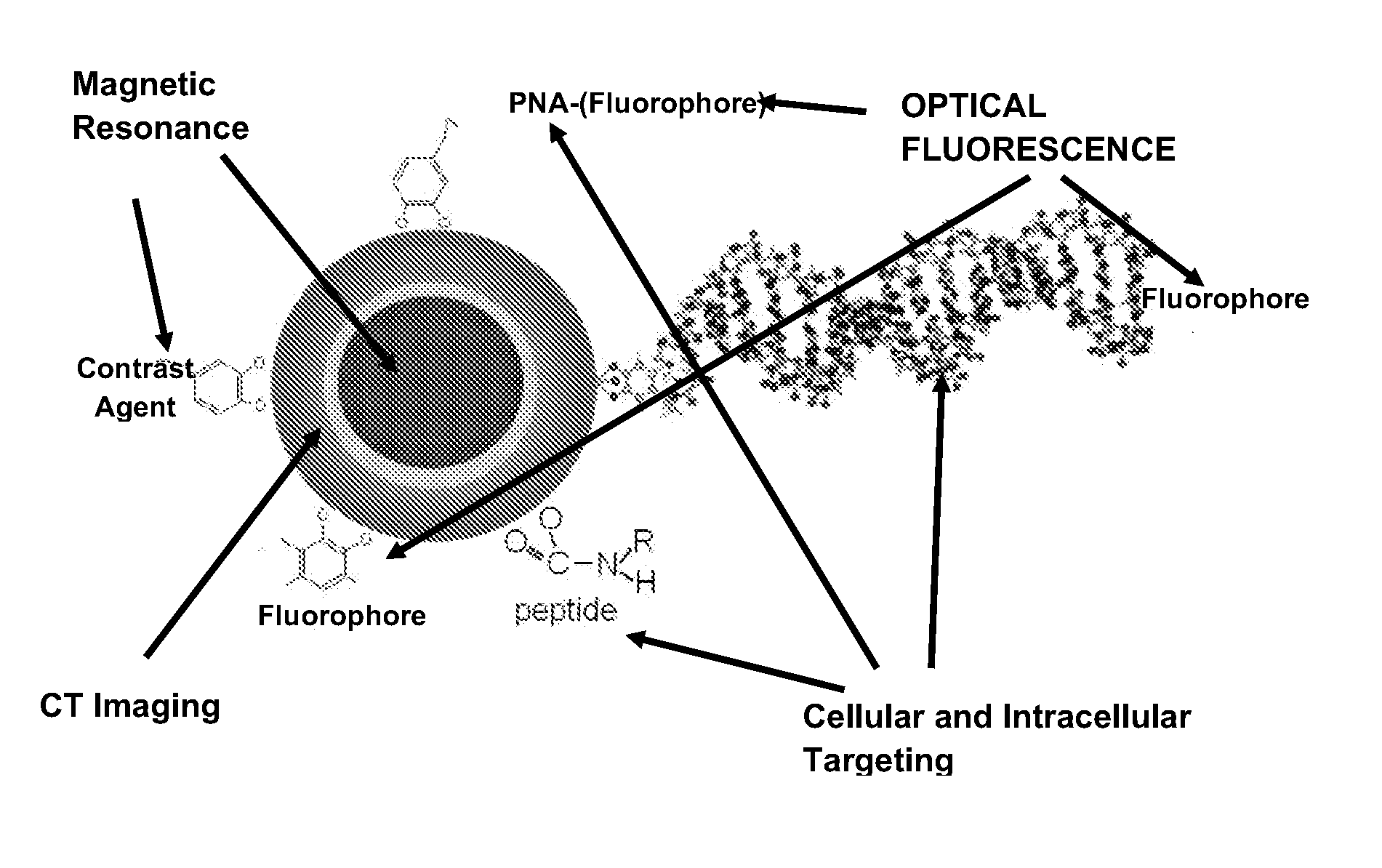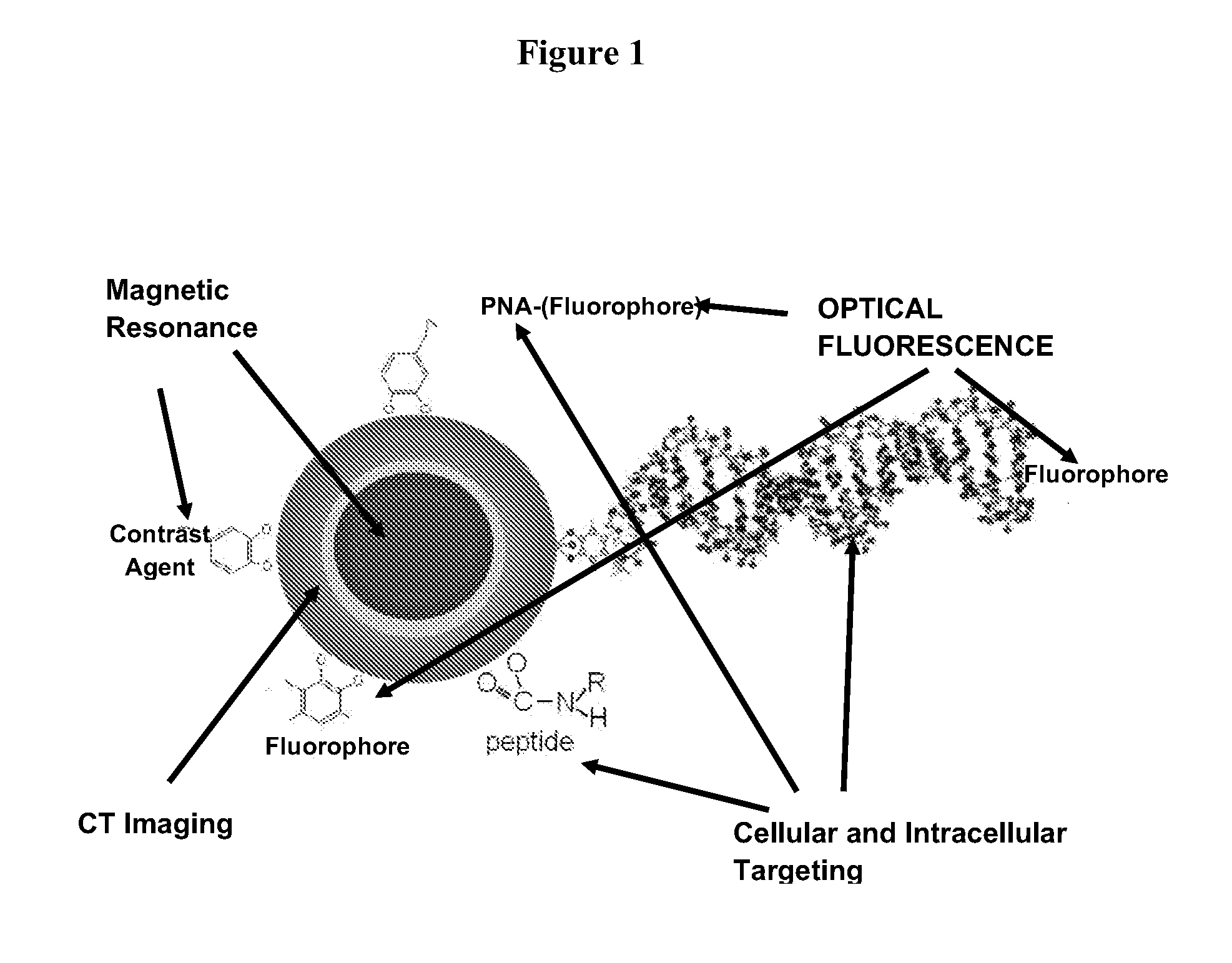Multifunction nanoconjugates for imaging applications and targeted treatment
a nanoconjugate, multi-functional technology, applied in the field of nanoconjugates, can solve the problems of lowering the therapeutic effect of such conventional treatments, affecting their health negatively, and not being able to discriminate well between target and healthy cells
- Summary
- Abstract
- Description
- Claims
- Application Information
AI Technical Summary
Benefits of technology
Problems solved by technology
Method used
Image
Examples
example 1
Core Nanoparticle Preparation
[0139]Particles a-d were purchased from commercial sources to use as controls.
[0140]a) 6 nm of anatase type of TiO2 as the nanomaterials with photoactive properties for CT. 10*40 nm of rutile type of TiO2 as the nanomaterials with photoactive properties for CT. CT images of Rutile type of 10*40 nm of needle-like TiO2-nanomaterials are shown in FIG. 2.
[0141]b) 10 nm of ZrO2 with bridging ligand-dextrans as the nanomaterials with photoactive properties for CT.
[0142]c) 8 nm of ZnO with bridging ligand-liposome as the nanomaterials with photoactive properties for CT.
[0143]d) 6 nm of ZnS with bridging ligand-liposome as the nanomaterials with photoactive properties for CT.
[0144]e) Preparation of 3 nm of α-Fe2O3 nanocrystal in aqueous solution and subsequent preparation of 30 nm of α-Fe2O3@TiO2 nanocrystal.
[0145]1) 3 g of anhydrous FeCl3 crystal salt was dissolved in 1 M HCl solution and kept in a final volume of 100 mL, the concentration of FeCl3 was 3%.
[0146...
example 2
Nanoparticle Surface Conjugation / Coating Using Different (Bio) Molecules and Different Conjugation Chemistries
[0271]a) Nucleic Acid Targeting of Intracellular Compartments
[0272]1) DNA oligonucleotide nanoconjugates (TiNCs) bind to appropriate target sequences in live mammalian cells; TiNCs specific for the nucleolus are retained in the nucleolus; those specific for mitochondria are retained in mitochondria, as shown in FIG. 8.
[0273]2) TiO2-DNA oligonucleotide nanoconjugates (TiNCs) bind to rDNA target sequences in live mammalian cell nucleoli, as shown in isolated nuclei in FIG. 9.
[0274]3) TiO2-DNA oligonucleotide nanoconjugates (TiNCs) bind to appropriate target sequences in live mammalian cells; TiNCs specific for the nucleolus are retained in the nucleolus; those specific for mitochondria are retained in mitochondria, as shown in FIG. 10 and FIG. 11.
[0275]4) Nanoconjugates with fluorescently labeled oligonucleotides, as shown in FIG. 12.
[0276]5) Nanoconjugates with fluorescent dy...
example 3
PNA-TiO2 Nanoconjugates
A. Materials and Methods
[0281]PNAs, DNA Oligonucleotides, Nanoconjugates, and Plasmids
[0282]All nucleic acid sequences used within this study are depicted in FIG. 17a. PNA containing a sequence of a segment of ribosomal 18S rDNA gene was synthesized with a dopamine conjugated via succinic acid to the N terminal end (Biosynthesis). PNA-TiO2 nanoconjugates were synthesized by covalently linking 3 nm TiO2 nanoparticles to the PNA in a 1:1 molar ratio as described previously for DNA oligonucleotides (Paunesku et al., Nat. Mater. 2003, 2, 343-346). Under these conditions some nanoparticles without PNA and some with more than one PNA molecule per nanoparticle can be expected to occur, in addition to one nanoparticle:one PNA nanoconjugate species. The DNA oligonucleotides used to prepare target oligonucleotide dsDNA “dsr18” and PNA complementary molecular beacon “r18ASMB1” (with 6-Carboxy-2′,4,4′,5′,7,7′-hexachlorofluorescein as a fluorophore and Dabcyl as a quencher...
PUM
| Property | Measurement | Unit |
|---|---|---|
| diameter | aaaaa | aaaaa |
| diameter | aaaaa | aaaaa |
| diameter | aaaaa | aaaaa |
Abstract
Description
Claims
Application Information
 Login to View More
Login to View More - R&D
- Intellectual Property
- Life Sciences
- Materials
- Tech Scout
- Unparalleled Data Quality
- Higher Quality Content
- 60% Fewer Hallucinations
Browse by: Latest US Patents, China's latest patents, Technical Efficacy Thesaurus, Application Domain, Technology Topic, Popular Technical Reports.
© 2025 PatSnap. All rights reserved.Legal|Privacy policy|Modern Slavery Act Transparency Statement|Sitemap|About US| Contact US: help@patsnap.com



